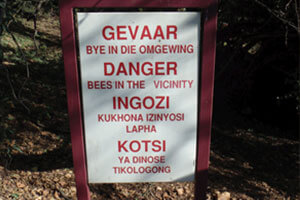
I started keeping bees when I was 12, roughly 26 years ago. When I first started keeping bees, I was very proud of my colonies and wanted to show them off to everyone. People from my church or my grandparents’ neighbors (I kept my bees on my grandparents’ farm) would stop by while I worked colonies and watch me do what a beekeeper does. I have been a bee-educator since that time, having taken thousands of people on tours of live honey bee colonies, through apiaries, etc. I confess, many of my early tours were quite cavalier. Someone would drive up to my apiary, hop out of their vehicle, and watch me work my colonies. Perhaps it was my naivety or that fact that I was a kid, but never once did it cross my mind that I may have put someone at risk, even if unintentionally. Certainly, now that I work for a university, the risks associated with negative public interactions with my bees, both my personal bees and those belonging to the university, cross my mind all the time.
Our bees are a source of wonder and endless amazement for us, notably so, given that we are beekeepers and got into the business due to our fascination with bees. However, our bees equally are a source of curiosity for our family, friends, neighbors, school groups, etc. Of course, we naturally want to share our craft with the adoring public. Yet, we must remember that bees, whether we feel strongly about this or not, pose a safety risk to humans and animals that interact with them. Thus, it behooves us to be vigilant and purposeful when making an effort to protect others from the bees we keep. I certainly understand that we do not want to contribute to the hysteria that naturally surrounds honey bees. If anything, we should work to eliminate that myth. But, it seems prudent to take steps to ensure the safety of any person or animal that may contact our bees. The older I get, the more concerned I am when I see other beekeepers take a caviler approach to facilitating public interactions with their bees. Given that our bees are “wild animals,” even if we do not want to admit it, one cannot be too careful when it comes to safety.
With all of this in mind, I have included in this article a list of recommendations one can follow in order to minimize negative interactions between ones bees and people/animals that may come into contact with them. I tried to make this list as thorough as possible, but please let me know if you feel that I omitted recommendations that would be of use to other beekeepers.
1) Locate your apiary/colonies away from areas where people and domestic animals frequent. – One of the best pieces of advice concerning bee safety is simply to keep your bees away from any area where a possible conflict might arise. For example, I do not recommend keeping a colony near a high-traffic trail of a city park, where kids congregate at school, or close to a nursing home. All of these areas increase the chances of negative interactions between bees and people. I think this is especially important given the popularity of bees and beekeeping today and the spread of our craft into urban/suburban areas. The Apiary Inspection Section of the Florida Department of Agriculture and Consumer Services (FDACS), Division of Plant Industry recommends that beekeepers not “place apiaries within 150 feet [45.7 m] of tethered or confined animals or public places where people frequent. (Examples – day care centers, schools, parks, parking lots, etc.)” (see FDACS 2013).
I want to make a special note regarding the tethered/confined animal statement. Generally speaking, most beekeepers keep their colonies away from areas people frequent, but give less thought about keeping colonies away from areas that animals frequents. The FDACS recommendation about keeping bees away from areas animals are confined or tethered (such as kennels, paddocks, small pens, cages, etc.) is born out of the fact that African-derived honey bees are present in South Florida and it generally is a good idea to keep managed colonies away from penned animals in the event the managed colony becomes Africanized. However, I still feel that it is a good recommendation in general and it limits the chances your that your bees will interact negatively with animals that are unable to escape if your bees attack them.
2) Site your bee colonies away from property lines. – I recommend siting colonies at least 15 feet (about 4.6 m), or more, from property lines. Bees leaving the colony need this distance to reach cruising altitude (i.e. above the head of the average human), thus helping to ensure that any passersby are out of the line of fire, so to speak. If colonies simply must be closer to the property line, for example – if you have a very small yard, you should create a flyway barrier at least 6 feet (1.8 m) in height near the hive entrance. This can consist of a wall, fence, dense vegetation, etc. and will cause the bees exiting the colony to gain altitude quickly, hopefully keeping them out of the way.
3) Make your colonies inconspicuous. – Conventional wisdom tells us to paint our colonies white and make them visible for our own enjoyment purposes. However, …


